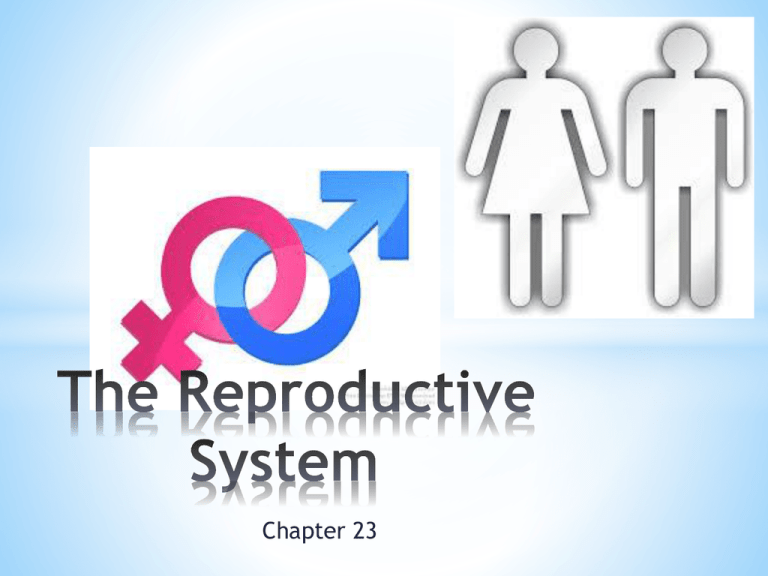The Reproductive System
advertisement

Chapter 23 Reproduction, or the process by which living organisms produce others of their kind. This is the main function of the human sex organs. The reproductive system is the body’s organs and structures that makes it possible to produce children. This is the only body system that is different for females and males. Several changes happen during puberty to make a female capable of having children. Though her body is not fully mature, this can lead to serious problems during a pregnancy. Three main functions of the female reproductive system are: 1. To store female reproductive cells. Egg cells are the reproductive cells from the female that join with a sperm cell to make a new life. 2. 3. To provide a place for the fertilized egg to grow into a baby. To give birth to the baby. . In general, every female is born with enough eggs to last throughout her child bearing years. Two glands, the ovaries, are the female endocrine glands that release mature eggs and produce the hormones estrogen and progesterone. Each ovary contains hundreds of thousands of egg cells. About once a month, one of the ovaries releases a mature egg. Ovulation is the process by which the ovaries release mature eggs, usually one each menstrual cycle. After ovulation, the egg cell travels through one of two fallopian tubes to the uterus. The uterus is a pear-shaped organ, located in the pelvis, in which the developing baby is nourished and protected. If sperm enter the vagina and travel to the fallopian tubes shortly after ovulation, the sperm and egg cell may unite. This is called fertilization, the joining of a male sperm cell and a female egg cell to form a fertilized egg. The male does not always have to ejaculate inside the female’s vagina for fertilization to occur. Fertilization is possible with ejaculate outside of the vagina or fertilization can even occur if the male deposits fluid from the penis near the vagina, even if he does not ejaculate. There only need be sperm cells present in the fluid. . If an egg is fertilized, the tissues in the uterus provide nutrients to the embryo, the newly formed organism during its first two months of life. If an egg is not fertilized, the lining in the uterus breaks and passes out of the body. The flow from the body of blood, tissues, and fluids that result from the breakdown of the lining of the uterus is called menstruation. Menstruation lasts from five to seven days. The amount of bleeding and length of cycle varies from female to female. When all of the blood and tissue have passed out of the body, the menstrual cycle begins again. The menstrual cycle is the hormonal change that occurs in females from the beginning of one menstruation to the next. Average is 28 days in most females. For most females menstruation begins between the ages of 10 – 15. Some experience cramps and soreness in the abdominal area. Premenstrual Syndrome (PMS) is a set of symptoms females experience prior to menstruation. Tired, nervous, worried, or depressed. Likely causes: stress, poor eating plan, and an imbalance of hormones. Yeast infections are caused by changes in the amounts of bacteria and fungi normal in the vagina. Itching and discharge brought on by hormonal changes, certain medicines (antibiotics), and tight clothing. Endometriosis occurs when tissue in the uterus grows in the ovaries, fallopian tubes, or the lining of the pelvic cavity. There is no cure for endometriosis, but treatment can help with pain and infertility. Vaginitis is an infection of the vagina treated with medication. Toxic shock syndrome (TSS) is a rare bacterial infection. Females who use tampons must read and follow the instructions that come with them very carefully. TSS is deadly when not treated and can be prevented. Choose tampons with the lowest absorbency for your menstrual flow. Change your tampon every four to six hours. Cancer can occur in the breasts, ovaries, uterus, and cervix. The cervix is the neck, or lower section, of the uterus. Caused by uncontrolled cell growth in the tissues of these organs. Sexually transmitted diseases (STDs) are diseases that are spread from person to person through sexual contact. Sterility is the inability to produce children. Causes: STDs, hormone imbalances, stress, diet, overexertion, and aging. Infertility is a reduced ability to produce children. Causes are the same as sterility. Ovarian cysts are growths on the ovary. Symptoms include a feeling of heaviness in the abdomen, pain, swelling, and bloating. Do a breast self-examination every month (BSE). The best time to check is about one week after the menstrual cycle ends. Lie down with a pillow under your right shoulder. Put your right arm behind your head. Place the three middle finger pads of your left hand on the right breast. Move the fingers in a circular motion applying light, then medium, then firm pressure. Use this process over the entire breast and lymph nodes. Repeat for left breast. Stand up and place your hands on your hips. Looking in the mirror, inspect your breasts for any changes. Look for dimpling, rash, puckering, discharge from the nipple, and scales on the skin or nipples. Raise your arms over your head and repeat the previous step. Examine your underarms. Bathe regularly, change sanitary pads/tampons every four to six hours, and change your underwear daily. Have annual medical check-ups. Medical exams that include a Pap test beginning at age 21, or earlier in sexually active. A Gynecologist is a doctor who specializes in the female reproductive system. Healthy females should have a Pap test every two years. Abstain from sexual activity to protect yourself from STDs and unplanned pregnancy. The male reproductive system produces sperm. Sperm are the male reproductive cells. Sperm are stored in the epididymis, a network of tubes behind the testes. The testes or testicles, are the reproductive glands that produce sperm. Males begin to make sperm cells between the ages of 12 and 15. The testes are located in the scrotum, which is a pouch of skin that holds the testes. The scrotum functions to keep the temperature regulated to the testes to produce sperm. The scrotum keeps the testes close to the body when cold and further from the body when warm. The mixture of sperm and fluids from the seminal vesicles, the prostate, and the Cowper’s glands is called semen. The body’s release of semen is called ejaculation, a series of forceful contractions. Approximately 3 to 4 million sperm are released with each ejaculation. . An erection is when the penis becomes upright and firm. This is due to an increased blood flow to the penis blood vessels. An erection can occur at any time, and for no reason. It’s a normal part of being a male. Ejaculation can occur when the penis is erect. Erections are not always followed by an ejaculation. Wet dreams are an erection followed by an ejaculation while you are sleeping. Also known as nocturnal emissions. They occur due to a build up of fluids in the reproductive glands. Most common in teen males going through puberty. Undescended testicle(s) is a condition in which one or both testes fail to descend from the abdominal cavity to the scrotum. This can be cured by surgery. Inguinal hernia is a condition in which the muscle that hold the intestines from descending into the scrotum become weak due to strain. A hernia is an internal organ pushing against or through a surrounded cavity wall. This is treated through surgery. Testicular cancer is the most common cancer for males age 14 to 34 and is one of the most curable forms of cancer. Early detection is essential for successful treatment. A testicular self-exam should be performed regularly, checking for lumps. Testicular torsion is when the spermatic chord becomes twisted around a testicle. Immediate treatment is necessary. Prostate cancer is when the tissue of the prostate gland becomes cancerous. It is most common in older men. Cancer treatments are necessary. Sterility is when a male produces too few sperm or if the sperm are weak. Caused by untreated STDs, exposure to pesticides, lead, certain drugs, or dangerous amounts of radiation, such as x-rays. Some types of sterility can be treated with medications or surgery. 1. Do a testicular self-exam every month. A good time is after or during a shower, when the scrotum is relaxed. 1. Roll each testicle between your thumb and fingers of both hands. Report any unusual lumps to your doctor. See page 547 illustration. 2. 3. Bathe regularly, especially if uncircumcised. 4. 5. Get regular physical checkups. 6. Abstain from sexual activity to protect yourself from STDs and unplanned pregnancy. Wear an athletic supporter or cup when participating in contact sports. Avoid wearing tight clothing.






